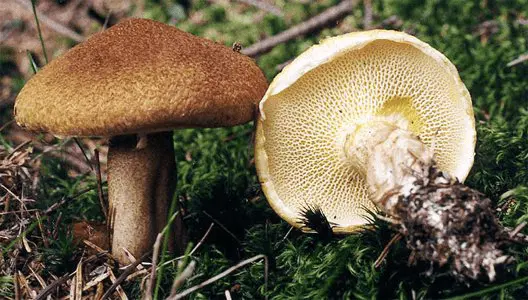Butter dish full-legged (Suillus cavipes)
- Division: Basidiomycota (Basidiomycetes)
- Subdivision: Agaricomycotina (Agaricomycetes)
- Class: Agaricomycetes (Agaricomycetes)
- Subclass: Agaricomycetidae (Agaricomycetes)
- Order: Boletales (Boletales)
- Family: Suillaceae
- Genus: Suillus (Oiler)
- Type: Suillus cavipes

Hat: in the full-legged oiler, the elastic, thin cap first has a bell-shaped shape, then becomes convex and flat with a wavy surface in a mature mushroom. A small protruding tubercle is clearly visible on the cap. The edges of the cap of the full-leg oiler are lobe-shaped, with fragments of the bedspread. The color of the cap during the ripening of the fungus changes from brown to rusty red and yellow. The cap diameter is up to 17 cm. The surface of the cap is dry, not sticky, covered with dark fibrous scales. The skin is covered with an almost imperceptible, thin fluff.
Leg: at the base, the stem is almost rhizoidal, thickened in the center, completely hollow. In rainy weather, the leg cavity of the full-legged oiler becomes watery. At the top of the leg, you can see an adhesive ring, which soon becomes ragged. For the hollow leg, the mushroom was called the butterdish polonozhkovy.
Pores: wide with sharp edges. Spore powder: olive-buff. Spores are ellipsoid-fusiform, smooth buffy-yellow in color.
Tubes: short, descending along the stem, tightly attached to the hat. At first, the tubular layer has a pale yellow color, then it becomes brownish or olive. The tubules have a relatively radial arrangement, the pores are rather large.
Pulp: fibrous, elastic can be light yellow or lemon yellow. The pulp has an almost inconspicuous smell and a pleasant taste. In the leg, the flesh is brownish in color.
Similarity: looks a bit like a flywheel, so it is also called half-leg flywheel. It has no resemblance to poisonous species.
Spread: It occurs mainly in cedar and deciduous forests. The fruiting period is from August to October. Prefers soils in mountainous or lowland areas.
Edibility: conditionally edible mushroom, the fourth category of nutritional qualities. Used dried or fresh. Mushroom pickers do not consider the butterdish mushroom to be valuable because of its rubber-like pulp.









